Is Powdery Mildew Harmful to Humans
Powdery mildew is generally not harmful to humans if touched or inhaled briefly. However, extended exposure, especially for those with allergies or respiratory issues, can cause irritation, such as coughing, sneezing, or eye discomfort. While it’s not toxic, consuming produce with powdery mildew is discouraged as it may cause mild stomach upset. To avoid potential irritation, it’s best to handle powdery mildew-infected plants with gloves and to trim or discard affected produce
If you’re in Montreal or Ottawa, our team can help you identify and deal with powdery mildew.
What is powdery mildew?
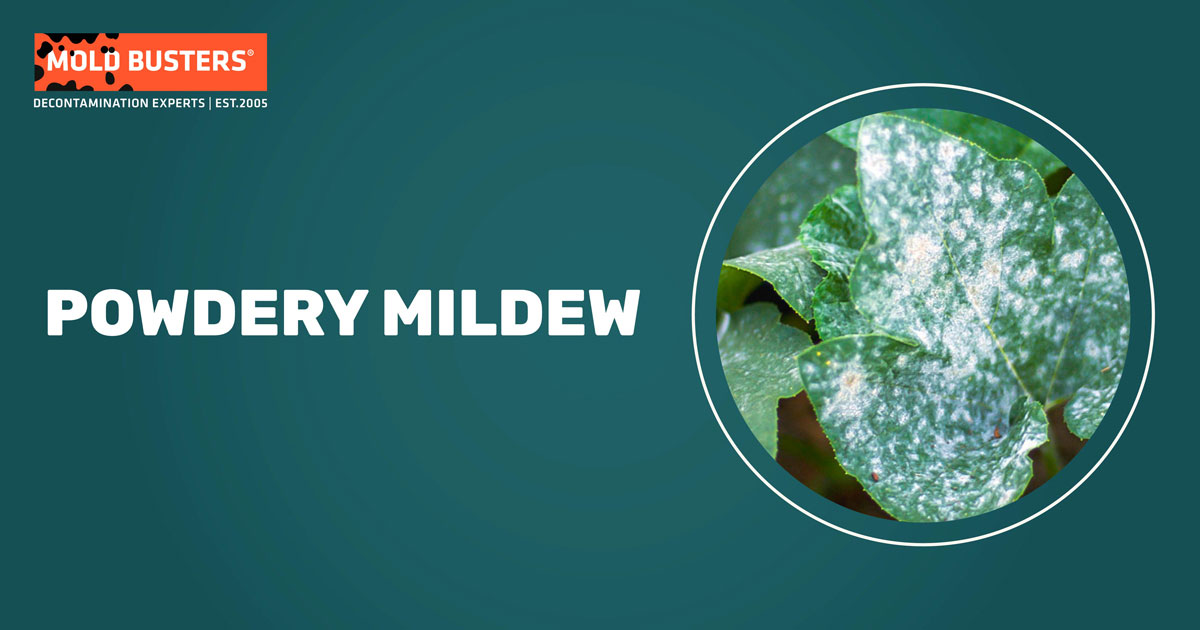
Powdery mildew is a fungal disease that appears as a white or gray powdery coating on the leaves, stems, and flowers of plants. It thrives in warm, dry environments and spreads through spores. Powdery mildew weakens plants by reducing photosynthesis, which can stunt growth and lower crop yields.
It is caused by various species of Erysiphales fungi, the most common reported cause being Podosphaera xanthii (also known as Sphaerotheca fuliginea) and Oidium. Different species will infest different plants with similar symptoms appearing on all of them.
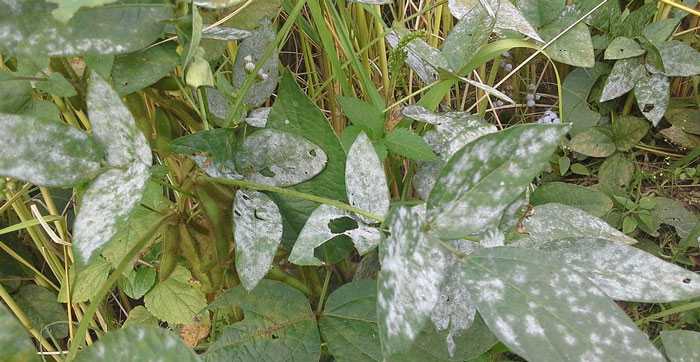
In most cases, spores spread via the air inside and around areas where the plants are growing. However, they can occasionally be spread by coming into contact with tools, animals or humans brushing against the plants.
This fungus reproduces incredibly quickly (both sexually and asexually), so if you don’t recognize it on time, it can destroy your entire crop. Luckily, anyone who regularly checks their plants can easily notice a contamination and take steps to prevent it from spreading.
In an agricultural setting, powdery mildew can be controlled using different chemical methods, genetic resistance and careful farming methods. We will go over some of these methods later in the article.
We offer mold inspection and mold testing services in Montreal and Ottawa to help you identify and control such issues.
What does powdery mildew look like?
Powdery mildew looks like a white or gray powdery coating on plant leaves, stems, and flowers. This coating often appears in patches and can spread to cover large areas of the plant, giving it a dusty or chalky appearance.
Powdery mildew is fairly easy to identify as its symptoms are quite distinctive:
- On infected plants, you will see white, powder-like circular patches (hence the name powdery mildew) on the leaves and stems.
- Usually, the lower leaves will be the most affected, but spots can also appear on any part of the plant that’s above the ground.
- Powdery mildew generally covers the upper side of the leaves, but it can also grow on the undersides.
- Young foliage is most frequently affected. Leaves turn yellow and dry out.
- The spores will get larger and thicker as the disease spreads, often forming a solid mat over the entire infected surface.
- Late in the growing season, the plant’s leaves, buds and growing tips will all become disfigured.
- In case of severe infections, you can expect stunted and distorted foliage, leaf drop and even fatal consequences on some plants.
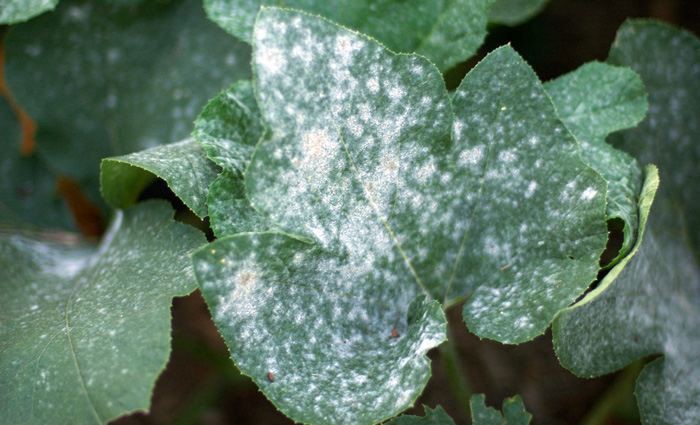
What causes powdery mildew?
Powdery mildew is caused by fungal spores that thrive in warm, dry environments with high humidity. Factors like poor air circulation, overcrowded plants, and damp conditions encourage spore germination and spread. The fungi spread through wind, insects, or water splashes, infecting plants and creating powdery growth on surfaces.
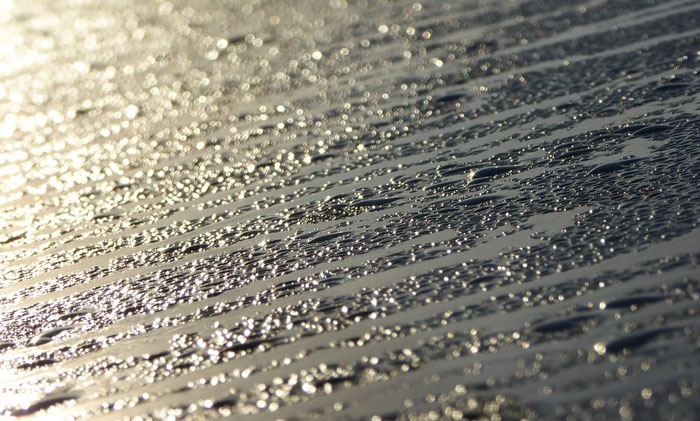
With all this in mind, we can easily conclude that this type of mildew is able to spread in many different conditions.
The main causes of powdery mildew are:
- High humidity. Because this fungus needs only small amounts of moisture to thrive, you can expect it to appear in any humid environment. This is particularly problematic for young cannabis plants since they need 40-60% relative humidity to grow.
- Poor airflow. If you have air circulating properly throughout your greenhouse or grow room, you have nothing to fear. However, when high humidity is combined with limited airflow, powdery mildew has all necessary conditions to thrive. So, if there is bad ventilation or no airflow in the area where you grow your plants, the spores will take advantage of the lack of fresh air to land on your plants and reproduce.
- Leaf-to-leaf contact. When the leaves of your plants touch each other, moisture forms between them. To prevent this, you can prune some of the leaves or space plants farther apart from each other so that their leaves never touch.
Is powdery mildew harmful?
Powdery mildew is harmful to plants, weakening them by reducing photosynthesis, stunting growth, and lowering crop yields. While it rarely kills plants, severe infections can lead to leaf drop, reduced flowering, and poor fruit quality. Powdery mildew does not directly harm humans or animals.
It won’t hurt you if you touch it, but if you are allergic to mold and you pick or consume a plant infected with mildew, you can have a serious reaction to it.
Your plants are the ones that are most affected by powdery mildew. As we already said, this fungus can infest a variety of plants, from grass and flowers to vegetables, fruits, grains and even cannabis.
This type of mildew can prevent your plants from blooming, and can even kill them. If an infected plant does manage to produce fruit, it will most likely be smaller and it will have a dull and inferior taste.
If you’re in Montreal, we offer mold inspection, mold testing, and air quality testing services to help you keep your plants healthy.
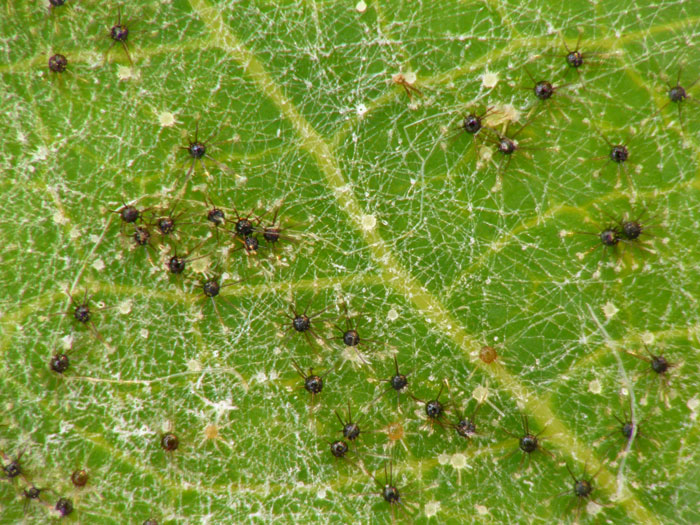
Is plant mold harmful to humans?
Some types of plant mold can be harmful to humans, especially molds that produce mycotoxins or spores that trigger allergies and respiratory issues. While common plant molds like powdery mildew are generally harmless, black mold and certain fungal pathogens can pose health risks if inhaled or ingested.
Can you eat powdery mildew?
Eating plants with powdery mildew is generally safe for humans, as the fungus itself is not toxic. However, powdery mildew can affect flavor and texture, and it’s best to remove affected areas or thoroughly wash the produce. For edible plants, prevention is ideal to avoid quality issues.
Is powdery mildew systemic?
Powdery mildew is not systemic; it affects only the surface of plant tissues, rather than infiltrating the entire plant. This fungus grows on the outer layer of leaves, stems, and flowers, drawing nutrients from plant cells but remaining localized rather than spreading throughout the plant’s internal structures.
But first, let’s explain what “systemic” actually means.
Systemic pathogens spread through a plant’s vascular system, while superficial pests spread across the surface of the plant.
Even though the debate is fierce, the most experienced growers claim that powdery mildew is not a systemic fungal pathogen. It does not reproduce in the plant cell—only on the surfaces of the plant, such as the stem and leaves.
Nonetheless, this does not completely eliminate the threat this fungus poses to your plants. As soon as you notice it, you should take appropriate steps to control and prevent it.
Where does powdery mildew grow?
Powdery mildew grows on the surfaces of plant leaves, stems, and flowers, particularly in warm, dry climates with high humidity. It prefers areas with low air circulation and shaded conditions. The fungus can infect a wide range of plants, including vegetables, flowers, and trees.
Besides being able to grow in a wide variety of environments, it can affect a number of different plants, such as:
- cucumber
- zucchini
- tomato
- rosemary
- peonies
- barley
- cannabis
- roses
- grass
Below, we will list certain plants that are particularly affected by this fungus along with the tips on how to prevent it from getting the best of your crop.
Does powdery mildew spread after harvest?
Powdery mildew does not typically spread after harvest, as it requires living plant tissue to grow and reproduce. However, existing mildew can continue to affect the appearance and quality of harvested produce, and spores can remain viable, potentially spreading to other plants if conditions allow.
Conclusion
Powdery mildew grows on many different plants and causes serious problems in gardens, fields and grow facilities. It usually thrives in small spaces with high humidity and insufficient airflow.
There are various solutions you can try today to remove this persistent fungus, from leaving more space between plants to applying some of the DIY anti-fungal mixtures.
When you use these methods, however, you can never be certain that you have removed the mildew completely.
The only option that guarantees success is a professional mold inspection and mold removal conducted by a team of experts. When you call us, you will know everything about the mildew on your plants—from what caused it to how to prevent it completely.
Get rid of powdery mildew for good and call Mold Busters today.

Get Special Gift: Industry-Standard Mold Removal Guidelines
Download the industry-standard guidelines that Mold Busters use in their own mold removal services, including news, tips and special offers:
Published: November 12, 2021 Updated: November 5, 2024

Written by:
John Ward
Account Executive
Mold Busters
Fact checked by:
Michael Golubev
CEO
Mold Busters
